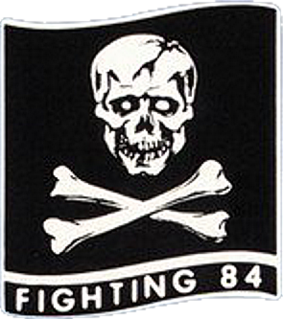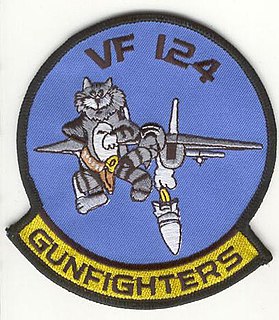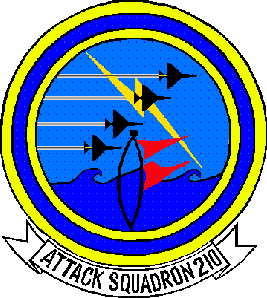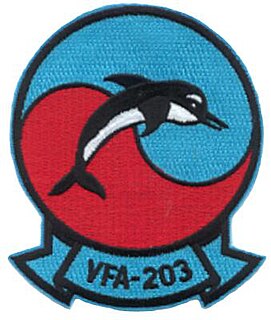
Strike Fighter Squadron 102 (VFA-102) is a United States Navy Strike Fighter squadron based at Marine Corps Air Station Iwakuni. Their call sign is Diamond, with the tail code NF, and they fly the F/A-18F Super Hornet.

The VFA-201, Strike Fighter Squadron was an aviation unit of the United States Naval Reserve based at Naval Air Station Joint Reserve Base Fort Worth, Texas (USA). It was established in 1970 as part of Reserve Carrier Air Wing 20 (CVWR-20) and deactivated in 2007. During its service VFA-201 could be identified by the tail code "AF" and nose numbers (MODEX) in the "100" series, typically 100 to 113. The squadron's nickname was the Hunters.

Strike Fighter Squadron 41 (VFA-41) also known as the "Black Aces", is a United States Navy strike fighter squadron based at Naval Air Station Lemoore, California, flying the F/A-18F Super Hornet. They are attached to Carrier Air Wing 9 (CVW-9). Their radio callsign is "Fast Eagle" and their tailcode is NG.

Strike Fighter Squadron 32 (VFA-32), nicknamed the "Fighting Swordsmen" are a United States Navy strike fighter squadron presently flying the F/A-18F Super Hornet and based ashore at Naval Air Station Oceana. Their radio callsign is Gypsy and their tail code is AC.

VF-84, Fighter Squadron 84 was an aviation unit of the United States Navy. Originally established as VA-86 on 1 July 1955, it was immediately redesignated as VF-84, it was disestablished on 1 October 1995. It was the third US Navy squadron to be designated as VF-84. The squadron was nicknamed the Jolly Rogers and was based at NAS Oceana. It took the number but not the lineage of VF-84 the "Wolf Gang" and the insignia of VF-61 the Jolly Rogers.

A carrier air wing is an operational naval aviation organization composed of several aircraft squadrons and detachments of various types of fixed-wing and rotary-wing aircraft. Organized, equipped and trained to conduct modern US Navy carrier air operations while embarked aboard aircraft carriers, the various squadrons in an air wing have different but complementary missions, and provide most of the striking power and electronic warfare capabilities of a carrier battle group (CVBG). While the CVBG term is still used by other nations, the CVBG in US parlance is now known as a carrier strike group (CSG).

Strike Fighter Squadron 2 (VFA-2) also known as the "Bounty Hunters" is a United States Navy F/A-18F Super Hornet strike fighter squadron based at Naval Air Station Lemoore, California. Their tail code is NE and their callsign is "Bullet". They are attached to Carrier Air Wing 2 (CVW-2), a composite unit made up of a wide array of aircraft performing a variety of combat and support missions that deploy aboard the Carl Vinson.

Marine Fighter Attack Squadron 142 (VMFA-142) was an aviation unit of the United States Marine Corps Reserve that was active from 1942 to 2008. At the time of its inactivation, the squadron was based at Naval Air Station Atlanta, Georgia and fell under the command of Marine Aircraft Group 42 (MAG-42), 4th Marine Aircraft Wing. Due to a re-organization within Marine aviation, the squadron moved to Naval Air Station Fort Worth Joint Reserve Base, Texas and was placed in a cadre status under Marine Aircraft Group 41.

VF-74, Fighter Squadron 74, Be-Devilers was an aviation unit of the United States Navy in service from 1944 to 1994. Originally established as VBF-20 on 16 April 1945, it was redesignated as VF-10A on 15 November 1946, redesignated as VF-92 on 12 August 1948, redesignated as VF-74 on 15 January 1950 and disestablished on 30 April 1994. It was the third US Navy squadron to be designated as VF-74.

Strike Fighter Squadron 101 (VFA-101), also known as the "Grim Reapers", was a United States Navy Fleet Replacement Squadron (FRS) based at Eglin AFB, Florida. After the West Coast FRS for the F-14 Tomcat, VF-124, was disestablished in the mid-1990s, VF-101 became the sole F-14 FRS. At the time it was based at NAS Oceana in Virginia. With the retirement of the F-14, VF-101 was deactivated in 2005. It was reactivated in 2012 and redesignated Strike Fighter Squadron 101 (VFA-101). It was one of two F-35C Lightning II FRS before being deactivated in 2019. It was based at Eglin AFB, Florida with the joint 33d Fighter Wing, as a subordinate unit of the U.S. Navy's Strike Fighter Wing, U.S. Pacific Fleet.

Fighter Squadron 124 or VF-124Gunfighters was a fleet replacement squadron (FRS) of the United States Navy. Originally established on 16 August 1948 as VF-53 it was redesignated VF-124 at NAS Moffett Field on 11 April 1958 due to a need for an increased number of flight training squadrons, itself necessary because of introduction of swept wing fighters into Navy service. In 1961, the squadron relocated to NAS Miramar, California, which would become the U.S. Pacific Fleet's Master Jet Base for fighter aircraft.

Strike Fighter Squadron 143 (VFA-143), also known as the "Pukin Dogs," is a United States Navy strike fighter squadron based at Naval Air Station Oceana, Virginia. The Pukin Dogs are an operational fleet squadron and flying the F/A-18E Super Hornet. They are currently attached to Carrier Air Wing Seven and USS George HW Bush. They are currently at their homeport of NAS Oceana. Their radio callsign is Taproom.

Strike Fighter Squadron 154 (VFA-154), also known as the "Black Knights", is a United States Navy strike fighter squadron stationed at Naval Air Station Lemoore. The Black Knights are an operational fleet squadron flying the F/A-18F Super Hornet. They are currently attached to Carrier Air Wing Eleven and deployed aboard the aircraft carrier USS Theodore Roosevelt. Their tailcode is NH and their callsign is "Knight".

VF-301 Fighter Squadron 301 was an aviation unit of the United States Naval Reserve in service from 1970 to 1994. The squadron's nickname was Devil's Disciples.

Fighter Squadron 302 (VF-302) was an aviation unit of the United States Naval Reserve in service from 1971 to 1994. The squadron's nickname was Stallions.

Naval Air Station Cecil Field or NAS Cecil Field was a United States Navy air base, located in Duval County, Florida. Prior to October 1999, NAS Cecil Field was the largest military base in terms of acreage in the Jacksonville, Florida area.

Attack Squadron 210 (VA-210) was an aviation unit of the United States Naval Reserve active between 1970 and 1971. VA-210 aircraft wore CVWR-20's tail code "AF", the squadron's nickname was Black Hawks.

VFA-203, nicknamed the Blue Dolphins, was a Strike Fighter Squadron of the U.S. Naval Reserve. It was established as Attack Squadron 203 (VA-203) flying the A-4 Skyhawk at NAS Jacksonville, Florida on 1 July 1970, as a reserve force squadron (RESFORON) under a new concept in the reorganization of the Naval Air Reserve Force. The reorganization was intended to make the reserves more compatible with active duty units and to increase their combat readiness. It was deactivated on 30 June 2004.

Fighter Squadron 194 or VF-194 was a short-lived aviation unit of the United States Navy established on 1 December 1986 and disestablished on 30 April 1988. It was the fourth US Navy squadron to be designated VF-194.
























